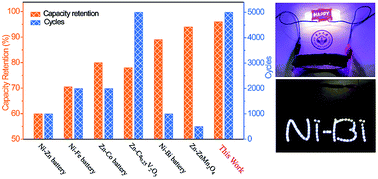Engineering high reversibility and fast kinetics of Bi nanoflakes by surface modulation for ultrastable nickel–bismuth batteries†
Abstract
The exploration of a stable and high-rate anode is of pivotal importance for achieving advanced aqueous rechargeable batteries. Owing to the beneficial properties of high conductivity, suitable negative working voltage, and three-electron redox, bismuth (Bi) is considered as a promising anode material, but it suffers from poor stability. Here, we successfully endow Bi nanoflakes (NFs) with prominent cycling performance by a one-step surface oxidation approach to remarkably boost its reversibility. As a result, the partially oxidized Bi NFs (BiOx) show an admirable capacity (0.38 mA h cm−2 at 2 mA cm−2), good rate capability and superior long-term stability (almost no capacity decay after 20 000 cycles). Furthermore, a durable aqueous Ni//Bi battery is constructed based on the optimized BiOx anode, which exhibits excellent durability with 96% capacity retention after 5000 cycles. This study could open a new avenue for the rational design of efficient anodes for eco-friendly and reliable aqueous rechargeable batteries.



 Please wait while we load your content...
Please wait while we load your content...